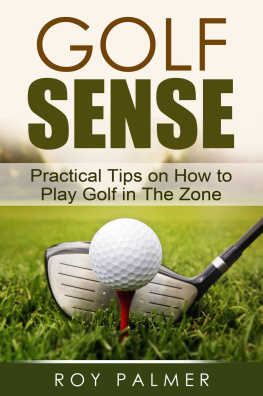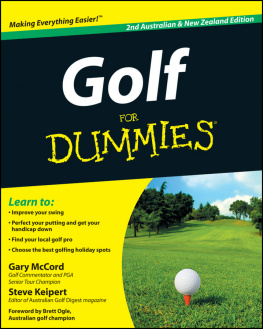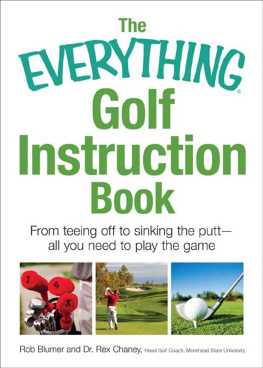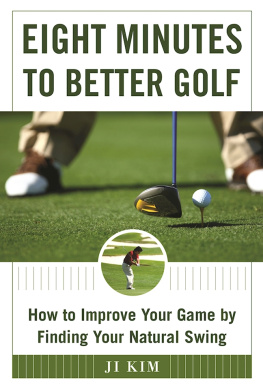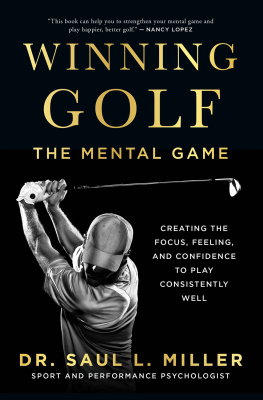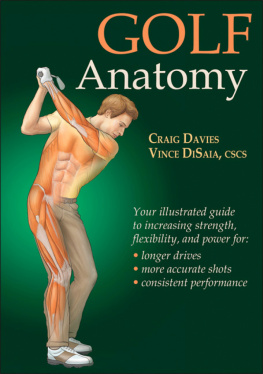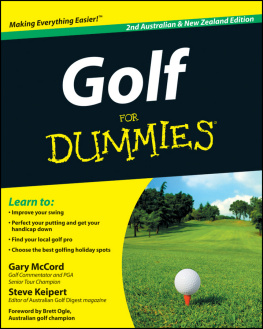Golf Sense
Practical Tips On How To
Play Golf In The Zone
Roy Palmer
Illustrated by Sophie Webber

FrontRunner Publications
G olf Sense: Practical Tips On How To Play Golf In The Zone
Text Copyright 2010 Roy Palmer
Illustrations Copyright 2010 Sophie Webber
ISBN 0956259308
C over design by Sophie Webber
Illustrated by Sophie Webber
Contact: littlestringers@hotmail.com
Layout design by FrontRunner Publications
Book text set in 11pt Palatino Linotype
First published in 2010 by FrontRunner Publications
Contact: roy@artofperformance.co.uk
T he right of Roy Palmer to be identified as the author of this work has been asserted in accordance with sections 77 and 78 of the Copyright, Designs and Patents Act 1988.
All rights reserved. No part of this publication may be reproduced in any material form (including photocopying or storing in any medium by electronic means and whether or not transiently or incidentally to some other use of this publication) without the written permission of the copyright holder except in accordance with the provisions of the Copyright, Designs and Patents Act 1988. Applications for the copyright holders written permission to reproduce any part of this publication should be addressed to the author.
Chapters
Introduction
1. Birdies And Butterflies
2. Doing The Right Thing?
3. Being In The Moment
4. Minding The Gap
5. The Now Moment
6. A Moving Experience
7. Seven Experiments To Transform Your Golf
8. Stepping Up To The Zone
9. Seize The Moment
10. Taking It To The Next Level
11. Playing In The Zone
Ten Steps To Playing In The Zone
Useful Resources
Introduction
A re you making your game too complicated? Do you sometimes feel that the more you try to get right, the more you get wrong? If all the dos and donts are preventing you from enjoying your golf, this book is for you. If, on the other hand, you play like a dream one day while the next day its the stuff of nightmares, this book is also for you.
Using simple techniques Ill show you how to simplify your golf to become a more consistent player by letting your natural game emerge. Initially these techniques may seem complicated due to the lengthy instructions. However, with practice youll find you can apply them in a fraction of a second and theyll make a big difference to your game. You can download audio instructions from my website; see Useful Resources.
The techniques I use may also differ to how youve practiced before. I place importance on what not to do, rather than what you think you need to be do. With experience Ive found this is the best way to unlearn bad habits that may be preventing you from playing your best golf.
Every player is different, so theres no need to strive to achieve that perfect, one-size-fits-all textbook shot. No two top golfers share the same technique. Theyre at the top because theyve learned how to play to their strengths and make the ball go where they want it to go with a high degree of success. Of course, there are certain cardinal rules that players have discovered over the history of the game, but how you apply these rules may in fact be preventing you playing to your full potential and maybe taking the enjoyment out of your game.
Its common sense that the more you play the better you get. But is it? Have you ever considered whether the hours you put in are productive? Are you over-complicating your game by trying too hard? Do you confuse yourself by attempting to do too much when lining up your shot? I believe in the less is more approach to training. Turn this around and you could think of it as: the more you attempt to do, the more there is to get wrong. Simplify your game and not only will your handicap come down, but youll also find youll learn so much more about golf.
I bet you already have a shelf full of excellent books on technique, golf fitness and how to improve your mental game. But do you have the ability to benefit fully from all this good advice and coaching? Im not talking about golf skills here, rather a fundamental skill that is the foundation for all learning.
The techniques I use here are easy to apply, regardless of your current golfing ability, and theyll help you get into The Zone a sublime state where suddenly life and sport dont seem quite so complicated. You may have experienced being in The Zone before, but probably rarely and for only a few fleeting moments. Most of us get into it almost by accident and hence dont know how to get back there again.
Before we go any further I feel I must make a confession. I dont play golf! Ive never swung a club in anger, although as a teenager I did get a hole in one at a pitch and putt course. I dont know much about tennis, horse riding, fencing or basketball either, but that hasnt stopped me helping hundreds of players from these sports. I do this by using procedures based on the remarkable system known as The Alexander Technique. Its a technique that will open up a whole new dimension to your game.
This dimension exists in the time between thinking and doing, what I call the now moment, and it lasts for only a fraction of a second. What you do in this briefest of moments can undo all of your previous good work. Although you may think youre totally switched on during this vital time, its quite likely youre unaware of many things youre actually doing, due to, paradoxically, your bodys process for repeating learned techniques and your efforts to do it right. Its these unknowns that can undermine your endeavours to play good golf and lead to inconsistency. Getting into The Zone heightens your awareness of what youre doing in the now moment. This allows you to reduce considerably those annoying little mistakes you find yourself making, in spite of knowing you shouldnt, plus quite a few more you may not be aware of.
I hope to encourage a subtle shift in your approach to golf that will dramatically change your understanding of what underpins your performance. I can show you how to develop a new skill or, as I see it, a new sense: a golf sense that will get you into The Zone more often and take your game to the next level.

1. Birdies And Butterflies
F ew people are better qualified to talk about chaos theory than golfers. One moment youre playing a shot like a pro and the next... Well lets not go there. With so many variables involved, the slightest move at the wrong time can put you in the rough, in a bunker or stranded somewhere up that unpleasant creek without a paddle. When it comes to sporting techniques there surely cant be one that has been analysed, agonised over, reinvented or written about more than the golf swing; and I bet the putt comes in a close second.
A golfer at the top of their game is a beautiful sight to behold, as science, art and skill combine to achieve what logically appears almost impossible. A thought creates a chemical reaction, translates into a billion electrical pulses, activates around 700 muscles and 206 bones to perform a miracle of coordination, organisation and implementation to achieve an expectation. If you tried to catalogue each and every single action in this brief moment it would take months, but you can do it in a second.
When it works well, it feels so simple and immensely satisfying. When it doesnt, it feels like each part of your body is doing its own thing in conflict with every other part. You might begin to wonder if youll ever be capable of doing it again.
So why the difference? What works so well one moment and not the next?
It only takes a tiny amount of inappropriate activity in one seemingly insignificant muscle to upset your rhythm and fluff the shot. Unfortunately, the majority of us simply dont have the degree of sensitivity or self-awareness to notice the small differences from one shot to the next.
Next page
